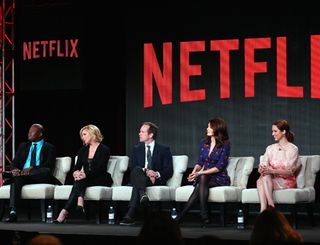OTT Plans Proliferate As Angst Level Rises

January has already featured a near-record flurry of over-the-top-viewing talk, at least judging by recent headlines emanating from CES and TCA. NATPE, unfolding this week in Miami, figures to be no different. From the show’s Brandon Tartikoff Legacy Awards (see special section beginning after page 10), which will honor Netflix’s Ted Sarandos, to panels boasting speakers from a host of new and long-standing players, not to mention business conversations up and down Miami Beach, the beguiling, bedeviling OTT acronym will be on the lips of many.
Some execs may not especially want to address the topic, but they have little choice. The television industry they entered as a newbie out of college, let alone what existed two or three years ago, has utterly metamorphosed as a tidal wave of content proliferates across platforms. Under the watchful eyes of the multichannel video programming distributors, the TV community and the ever-curious press, execs have had to establish a position that is with-it and tech-savvy while being bottom-line oriented and respectful of traditional distribution partners. Sometimes, the strain of that balancing act is evident.
“Almost every day, we get asked questions about over-the-top—how, when, where,” Showtime president David Nevins said during his executive session at TCA. While he said mobilizing an OTT service is “certainly something we’re prepared” to do, he tried to keep the focus on current and upcoming shows, regardless of how they reach viewers. “What I want to talk about is how we’re preparing for the future from a programming point of view.”
Trouble is, especially for the higher-end premium outlets that are in a pitched content battle with Netflix, Amazon, Hulu and other streaming services, the conversation can only be redirected for so long. HBO last fall, after seeing Netflix gain ground and also seeing traction for its digital service HBO Go, announced plans to launch a stand-alone over-the-top offering modeled after HBO Go by year-end. The hope is that it can close the gap between its roughly 30 million U.S. subscribers and Netflix’s 37 million. CBS, meanwhile, has launched CBS All-Access, which for about $6 per month offers a fairly complete selection of CBS programming, minus NFL football, to non-MVPD subscribers.
Follow the Money
Pricing plays a pivotal role in terms of politics with distributors and consumer perception of OTTs. Some content providers privately have groused about the $20 Dish plans to charge for its Sling TV package being too low, though the lack of broadcast networks (or even cord-cutter- friendly ones from Viacom or FX) does make it seem unlikely a higher rate would stick. A study from Parks Associates recently found that 75% of those who own streaming media players subscribe to an OTT service rather than subsisting on free content (though yes, there still is some). The attractiveness of Google and Amazon and Roku dongles costing less than $40 obscures the new reality of unbundled content, wherein individual services add up and can ultimately cost more than the old-fashioned cable bundle that OTT was designed to improve upon.
Chris Albrecht, CEO of Starz, faced the inevitable question at TCA and took a few minutes to break down what constitutes a true OTT. One variety of it, the direct-to- consumer path taken by HBO and CBS, is something Starz is “far away from,” he said. “It’s an interesting proposition and one that I don’t see in Starz’s immediate future.” The company, as it has indicated on recent earnings calls and in other comments, is actively pursuing OTT packages internationally and likely domestically via the “virtual MVPDs” taking root on gaming consoles and similar platforms. Should that kind of scenario develop, Albrecht added, “I’m not sure that [direct-to-consumer] becomes more lucrative or worth the risk. But I don’t know what other companies will do.”
Broadcasting & Cable Newsletter
The smarter way to stay on top of broadcasting and cable industry. Sign up below
During CES, which was kick-started by Dish banging the drum (literally) for its Sling TV digital TV service, CBS Corp. CEO Leslie Moonves was among the TV execs touting the upside of exploring new distribution methods—certainly a viable message for the tech crowd.
Managing to simultaneously plug CBS All Access and continue diminishing the value of overnight Nielsen ratings, Moonves proclaimed, “As a content provider, we don’t care where you watch it or when you watch it,” he said. “We just want it to be counted and be paid appropriately.”
Farther down the Las Vegas Strip, the newest vertical at CES, called C Space, was weighing the OTT question throughout its three-day run of panels and exhibits centered on branded content. Neal Mohan, VP of video advertising at YouTube, noted during a C Space headline session that multiscreen usage was up 500% over the past three years, with Americans consuming some 1.2 billion pieces of video a day. The Internet has dwarfed other media in terms of usage, across, as Mohan noted, “millions of websites and thousands of apps.” In a single generation, he added, “We’ve gone from this world of scarcity to a world of true abundance.”
Mohan’s colleagues at YouTube as well as the broader Google team are pressing on with their video efforts, sensing that the “top” may be dropping out of “over-the-top.” The company is rolling out the Nexus Player, a $99 streaming box based on Android TV that adds voice control and other features to the basic Chromecast streaming options. It is just the latest example, noted MediaLink president Wenda Harris Millard, of tech companies like Google, Amazon, Apple and Roku, with their war chests and innovation machinery, seeking consumer cachet through OTT offerings and an emphasis on personalization. “As big as they are, these players are thinking small,” Millard said at the start of a CES panel. “On the other hand, the traditional media companies…are engaged in an existential effort to re-imagine themselves as technologically enabled companies rather than publishers and broadcasters.”
